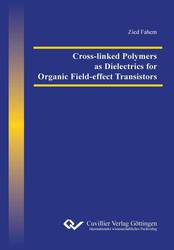| Fachbereiche | |
|---|---|
| Buchreihen (96) |
1378
|
| Nachhaltigkeit |
3
|
| Gesundheitswesen |
1
|
| Geisteswissenschaften |
2362
|
| Naturwissenschaften |
5406
|
| Mathematik | 229 |
| Informatik | 319 |
| Physik | 980 |
| Chemie | 1363 |
| Geowissenschaften | 131 |
| Humanmedizin | 243 |
| Zahn-, Mund- und Kieferheilkunde | 10 |
| Veterinärmedizin | 108 |
| Pharmazie | 147 |
| Biologie | 835 |
| Biochemie, Molekularbiologie, Gentechnologie | 121 |
| Biophysik | 25 |
| Ernährungs- und Haushaltswissenschaften | 45 |
| Land- und Agrarwissenschaften | 1004 |
| Forstwissenschaften | 201 |
| Gartenbauwissenschaft | 20 |
| Umweltforschung, Ökologie und Landespflege | 148 |
| Ingenieurwissenschaften |
1790
|
| Allgemein |
97
|
|
Leitlinien Unfallchirurgie
5. Auflage bestellen |
|
Erweiterte Suche
Cross-linked Polymers as Dielectrics for Organic Field-effect Transistors
Zied Fahem (Autor)Vorschau
Leseprobe, PDF (95 KB)
Inhaltsverzeichnis, PDF (25 KB)
Organic electronics are getting more and more interest from industrial companies and research groups in the last years since they enable many new applications, which could not be realized by inorganic materials [1{7]. Flexible displays 1, large-area sensors 1, light-emitting large surfaces 8, printable radio-frequency identification tags (RFID) for packaging or logistic industry 2 and many other systems which require exible, large area and low-cost electronic devices are now developed for the near future or even already commercialized. Organic light-emitting-diode (OLED) displays, for example, are now implemented in portable devices and have higher performance than the traditional LCD displays 9. OLED displays are self illuminating and do not need back lightening, therefore they have higher brightness, contrast and viewing angle in comparison to LCD displays 9. Many electronic devices producers implemented OLED displays in their high-end smartphones and SLR cameras 10, and recently LG (a Korean company) introduced a 55-inch OLED television 11. Large-area solar cells based on organic materials have also found their way to commercialization 12.
All of these innovations were only possible after the introduction of organic conductors and semiconductors. Organic (semi)-conductors have the advantage of their low-cost processing technologies (e.g. printing or spray-coating). However, they have lower electrical conductivity, free charge carriers mobility 13 and packaging density than their inorganic counterparts. Therefore they are normally used in lowcost and low-performance applications, except in the case of OLED where they have clear advantages compared with other technologies.
In order to produce fully exible devices, elementary devices for electronic circuits (e.g. transistors and diodes) need to be made with exible materials. The performance of these devices needs to be enhanced and their fabrication processes should be optimized to ensure their commercialization as switching elements in OLED displays or in other circuits. These tasks are principally a material issue, that means new materials with higher performance and easier processability are sought after. Most of the work done in this direction is devoted to synthesize new semiconducting materials with higher mobility and solution-processability. Parallel to these investigations, new dielectric materials with good dielectric properties even in thin films, solution-processability and good interface properties to the semiconductors should be developed. Cross-linked polymers are advantageous for organic field-effect transistors (OFETs) because of their electrical and chemical properties, specially their high volume resistivity and their stability towards solvents, acids and bases. This work shows that the application of cross-linked materials can also reduce or even eliminate the use of the volatile organic compounds (VOC), for which legal limitations are yearly augmented.
| ISBN-13 (Printausgabe) | 9783954045617 |
| ISBN-13 (E-Book) | 9783736945616 |
| Buchendformat | A5 |
| Sprache | Englisch |
| Seitenanzahl | 112 |
| Auflage | 1. Aufl. |
| Erscheinungsort | Göttingen |
| Promotionsort | Hamburg-Harburg |
| Erscheinungsdatum | 21.11.2013 |
| Allgemeine Einordnung | Dissertation |
| Fachbereiche |
Chemie
Elektrotechnik |
| Schlagwörter | Dielectrics, Field-effect transistors, organic electronics, printed electronics, Allgemine Elektrotechnik, Organische Chemie |








